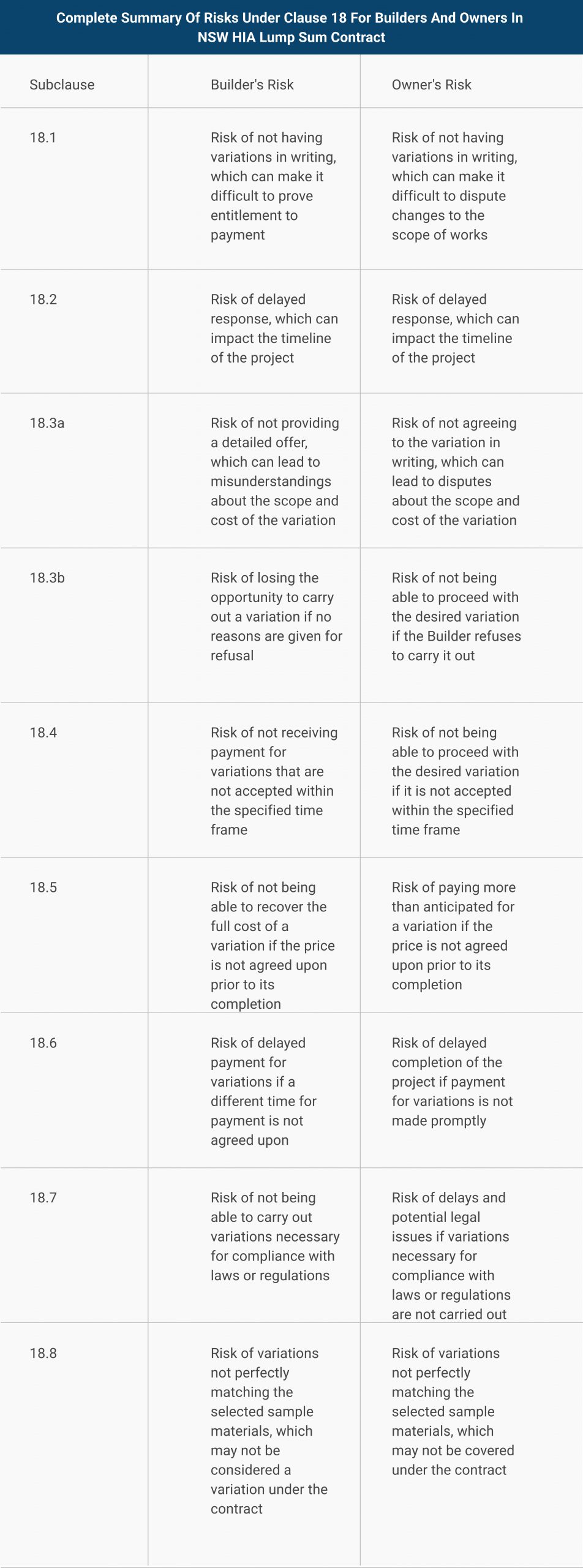Risks to Builders
Builders face several risks under Clause 18 of the NSW HIA Lump Sum contract.
Here are some examples of the potential risks they face:
- Subclause 18.3(a) – A signed written offer to carry out the variation detailing the work required, the price, and any extension of time. The risk to builders is that they may underestimate the cost or time required to complete the variation, leading to additional work and delays.
- Subclause 18.4 – If the owner does not give written acceptance within 5 working days, the builder’s offer is deemed to be withdrawn. The risk to builders is that they may have already expended resources or started work on the variation, only to have it fall through due to the owner’s failure to respond in time.
- Subclause 18.5 – If the price of the variation is not agreed prior to it being carried out, the builder may be exposed to additional work and costs. This subclause requires the deduction of the reasonable cost of all deletions from the building works, and the addition of the total cost of all extra work plus the builder’s margin applied to that cost.
Benefits to Builders
Clause 18 provides builders with several benefits that can help them avoid disputes and ensure they are fairly compensated for additional work.
Here are some potential benefits of each subclause:
- Subclause 18.1: Having variations in writing helps to ensure that both parties are aware of any changes to the scope of work and can avoid any confusion or disputes.
- Subclause 18.2: The ability to respond to an owner’s request for a variation in writing allows the builder to carefully consider the proposed changes and provide a clear response, which can help avoid misunderstandings.
- Subclause 18.3: The requirement for a signed, written offer to carry out a variation provides a clear agreement between the builder and owner, which can help avoid disputes down the line. Additionally, including details on the work required, price, and any extensions to the building period helps to ensure that both parties are on the same page.
- Subclause 18.4: The requirement for the owner to give the written acceptance of the builder’s offer helps to ensure that both parties have agreed to the proposed variation and can avoid any misunderstandings or disputes.
- Subclause 18.5: The requirement for the price of a variation to be agreed upon before work begins helps to ensure that builders are fairly compensated for any additional work they do.
- Subclause 18.6: The requirement for payment of the price of a variation at the next progress payment helps to ensure that builders are paid promptly for any additional work they do.
- Subclause 18.7: The requirement for owners to not unreasonably withhold consent to variations that are required by law or statutory authority can help builders avoid disputes and delays in the construction process.
- Subclause 18.8: The acknowledgment that natural materials can vary helps builders avoid potential disputes over differences in materials.
Risks to Owners
Homeowners face certain risks when entering into a building contract, and Clause 18 is designed to help mitigate some of those risks. However, it’s important to understand the potential risks that owners face under the terms of the contract.
- Subclause 18.2: If the owner asks for a variation, the builder must reply in writing as soon as is reasonable.
Risk: Owners may face delays in receiving a response to their request, which could cause delays in the project’s completion.
Example: If the owner requests an additional room, but the builder does not respond for several weeks, the owner may face delays in moving into their home.
- Subclause 18.3(a): If the owner accepts a variation, they may face additional costs and delays to the project’s completion.
Risk: Owners may be exposed to additional costs for the variation, as well as any delays that may result from carrying out the variation.
Example: If the owner requests a change to the home’s roofing material, they may face additional costs and potential delays if the materials are not readily available.
- Subclause 18.5: If the price of a variation is not agreed upon before it is carried out, the owner may face additional costs for deletions from the building works.
Risk: Owners may be exposed to additional costs if deletions from the building works are required.
Example: If the owner decides to remove a window after it has been installed, they may be responsible for the cost of deleting the window from the building works.
- Subclause 18.7: The owner must not unreasonably withhold consent to any variation required for the building works to comply with the law or a requirement of any statutory or other authority.
Risk: Owners may face additional costs if they unreasonably withhold their consent for a variation that is required for the building works to comply with the law.
Example: If the owner refuses to approve a variation required to meet building code requirements, they may face additional costs for remediation or fines from the relevant authorities.
Benefits to Owners
Clause 18 of the NSW HIA Lump Sum contract is not only beneficial to builders but also to owners. The clause provides clear and specific agreements that can benefit the owner in the following ways:
- Transparency: Written variations provide transparency and accountability for both parties, ensuring that the owner knows exactly what they are paying for and why.
- Control: Having a clear understanding of the variations and their cost allows the owner to control their budget and make informed decisions about the progress of the building work.
- Compliance: The clause also ensures that any necessary variations to comply with building regulations or statutory requirements are done in writing, avoiding any issues with non-compliance.
- Reduced Risk: Written variations provide a level of protection to the owner against any potential claims of extra payment or delays in completion.
Examples of situations where owners can benefit from having variations in writing include changes in the scope of work, compliance with building regulations, and issues with materials or workmanship that need to be addressed.
By having variations in writing, the owner can be assured that the work being done is in accordance with the contract and that they are protected from any unexpected costs or delays.






